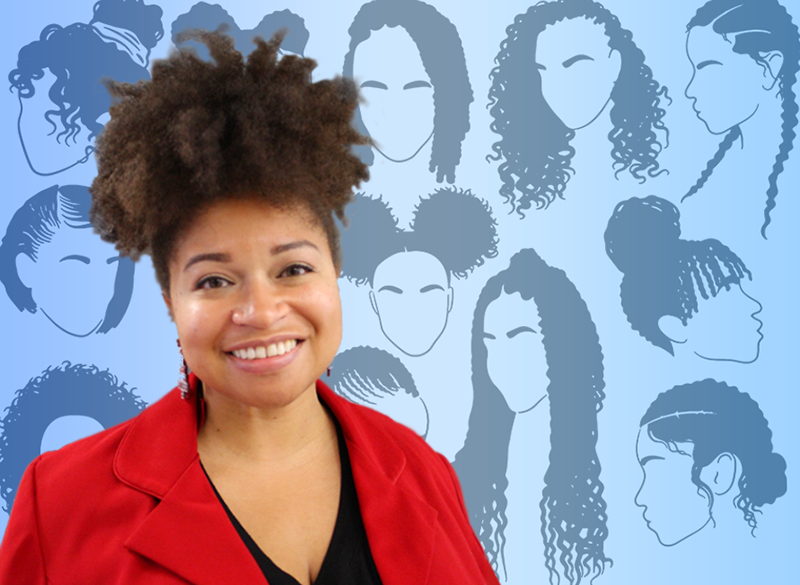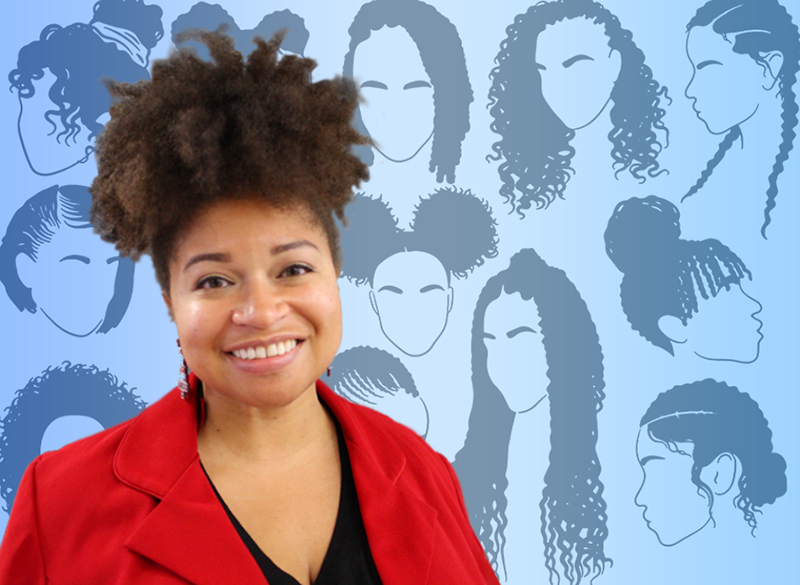The Mechanics of Curly Hair
With a full head of tightly coiled ringlets, Michelle Gaines spends a lot of time thinking about how to control curly hair. “If I didn’t have to think so much about my hair—and my daughter’s hair—I’d get hours back in my life,” she says. Now, as an assistant professor of chemistry at Spelman College, a historically Black women’s liberal arts school in Atlanta, she’s also made it her mission to measure the mechanical and geometric properties of curly hair—and to glean physics-based information about which products might be best suited to care for it.
Gaines became interested in curly materials as a high schooler, when her mechanical-engineer father brought her to a “take-your-daughter-to-work” day and introduced her to a female materials scientist. Gaines decided then that studying materials was for her. After completing her PhD in chemical engineering, she took an internship at Procter & Gamble, a consumer goods manufacturer in Cincinnati, where she got hands-on experience measuring the mechanical properties of elastomers and other types of polymers. Through her research, she became acutely aware that brushing and styling her own curly hair each day was like a materials science experiment.
At last month’s American Chemical Society meeting, Gaines presented her approach to measuring hair and ideas for how it could lead to new and improved natural-hair care. Physics Magazine spoke to her about this work.
All interviews are edited for brevity and clarity.
Why study hair?
My own hair frequently changes its shape and appearance in many ways. That affects my daily life. Back in 1995 when my parents worked in the corporate world, Black women like me had to straighten or braid our hair to fit in. But the care products available for our type of hair were limited. The common hair taxonomy—developed by cosmetics brand L’Oréal—had four categories: straight, wavy, curly, and kinky. But most of the products catered to either straight or wavy. Many Black women settled for “wavy” hair products, but they didn’t work for styling our natural hair in what was considered an acceptable way.
I realized that in addition to being a societal problem, this problem was a polymer-materials one, in that different hair types have different mechanical properties. What we needed was a better way of classifying curly and kinky hair and providing more information on the kinds of personal care products that will best resonate with these curl patterns.
How did you go about classifying hair?
My students and collaborators collected dozens of samples of different types of hair and examined them under a microscope. We came up with new geometric parameters to describe the strands and attempted to correlate a strand’s geometry to its mechanical performance and surface structure. That led to what we call the stretch ratio, a parameter that quantifies the force required to uncurl a strand until it’s straight. This parameter scales directly with how many complete waves, curls, or coils—in other words, how many contours—exist in a fixed strand length.
Can a person measure this parameter for themselves?
Yes. Pluck out a strand of your hair and place it unstretched on a ruler. Then, by simply counting the number of contours that repeat within a certain length, you can say “my hair fits into this type and this shape” and give it a number. Our parameter mostly lines up within the qualitative system developed by celebrity hairstylist Andre Walker. Eventually, after collecting more data, we plan to use this scale to suggest product ingredients, according to a person’s number on our scale.
Is it hard to figure out the right product?
It is for curly hair types because scientists don’t fully understand what moisture does to hair. Each hair fiber is covered with a cuticle, which is a sheath of fatty acids and keratin cells that overlap each other like roof shingles to protect the hair’s inner cortex. The cuticle layers open and close when exposed to water or shampoo and other products. My group is studying cuticle behavior for different hair types. What we’ve found is that curly hair has lower porosity, with cuticle layers that are much closer together than in less-curly counterparts. The result is that kinkier hair has a harder time becoming saturated with water.
Is this related to hair staying curly on a humid day?
Yes. Hydration is the enemy of straightening curly hair. But now it’s our best friend, because it defines the curl in its most natural state. When hairs are allowed to stay saturated and dry on their own, they achieve their natural curl. That’s because they’ve had the chance to soak in the moisture. When you have nicely bundled curls, it’s because they’re hydrated. But when the hydration leaks, the hair starts to look for water and frizzes out, losing its natural curl.
What does this mean for hair care?
We know that curly and kinky hair dries out faster than wavy and straight hair, but the connection to porosity is an exciting find. It could explain why maintaining hydration is the key to maintaining natural hair.
As for making better hair products, perhaps manufacturers could use hydrogel materials to control hydration. But there’s so much left to identify about the native state of the hair—not just curly hair but also wavy hair. There are connections that we simply haven’t established yet.
–Rachel Berkowitz
Rachel Berkowitz is a Corresponding Editor for Physics Magazine based in Vancouver, Canada.





